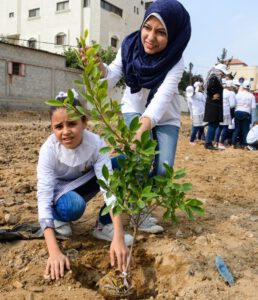The Greenest Country in the World
Are you familiar with the greenest country in the world? It certainly is not the country pictured here, which is Jordan, showing Al Hisha Forest, one of our current restoration projects. Measured by current standards, the greenest country must be carbon negative. This means that the trees and other plant life absorb more carbon than the country produces. Does such a country exist? And why is everyone talking about trees these days? Why do we hear almost daily about the launch of a new tree-planting initiative where the leader of the respective country tries to trump a previously announced project with a few million more trees? Personally, I wonder how all these millions of trees survive. This seems to be a rather relevant question, in a time of rising temperatures and increasing water scarcity.
Why all these questions? you ask. I understand. You prefer answers. You say: the world is complicated enough already. Tell me what I can do today to address the climate problem, and then I can get on with my life tomorrow. My answer would be: plant a tree in your backyard. Will that make the world better? Yes. Will it significantly reduce global warming? No. But before you stop reading, let me take you on a short journey.
Five years ago, on our wedding anniversary, my wife and I decided to plant a side hornbeam in the postage stamp that is our backyard. The landscaper we hired said:
“You are the first people to have a tree planted in their yard in a long time. Most of my clients ask me to remove their trees.”
As the director of an organization involved in restoring degraded land, I know that a few hundred trees planted in backyards is not the solution. And yet one of Menaqua’s most successful activities in the past year was teaching 300 schoolchildren how to plant a tree and, more importantly, how to grow it.
Although it was only 300 trees, the community responded enthusiastically. These were the schoolchildren themselves, some of whom had never seen a tree ‘up close’ before, as well as their parents, teachers and government employees involved in preparing the planting sites. The simple act of planting a tree has also sown a seed for nature stewardship, an essential condition for sustainable planting.
So, my answer is also: perhaps it is better to plant only a few hundred trees and make sure that every tree is lovingly tended, than to put a million trees in the ground and hope they will produce the desired result. In all the countries I have visited in the Middle East over the past five years, I have witnessed the megalomaniacal tree-planting projects from the past that – for various reasons – have been unsuccessful. I have seen a lot of dead trees.
But back to the greenest country in the world, a title currently held by Bhutan. Not only does Bhutan have negative carbon emissions, but the constitution also mandates that at least 60% of the country be maintained and protected as forest at all times. This mandate extends to protecting forests from ‘destructive’ local people, a narrative that was embedded during colonial times and is still strong today.
 This approach is arguably not the way to go to make the world greener and to combat global warming together. But what I am learning is that we first have to understand a country’s narrative, then try to challenge the local people to talk about it and eventually find each other as partners in a common mission. It’s something you have to grow into. There’s a reason why our slogan is: We listen. We learn. We plant. We grow.
This approach is arguably not the way to go to make the world greener and to combat global warming together. But what I am learning is that we first have to understand a country’s narrative, then try to challenge the local people to talk about it and eventually find each other as partners in a common mission. It’s something you have to grow into. There’s a reason why our slogan is: We listen. We learn. We plant. We grow.
Ultimately, only you can decide whether you should plant a tree in your backyard, but hopefully I have succeeded in challenging you to consider it. Your tree might not change the world, but one thing is certain: every tree that is nurtured to maturity counts.
